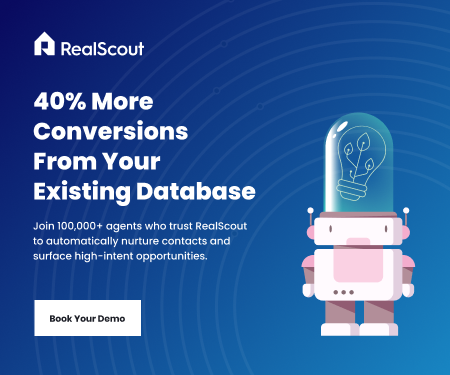Imagine this: Your team just closed a successful transaction. The champagne is flowing, everyone’s celebrating—and meanwhile, a hot lead in your database is giving off clear high-intent lead signals that they’re ready to buy… but no one notices. Three weeks later, you discover they’ve gone with another agent.
This scenario plays out daily for real estate teams across the country. While most focus only on direct inquiries (“I want to see this house”), the highest-performing teams have learned to identify and act on the subtler high-intent lead signals that indicate a contact is ready to transact.
By recognizing these less obvious behaviors, top-performing teams consistently convert 40% more opportunities from their existing database without spending an additional dollar on lead generation.
Let’s explore the five most powerful high-intent lead signals you might be missing—and why they matter to your bottom line.
Key Takeaways
- The cost of missing high-intent lead signals is substantial. Research shows 93% of past clients and sphere contacts end up listing with other agents due to inconsistent follow-up, representing billions in lost volume and potential commissions.
- The 5 most powerful high-intent lead signals include multiple property value checks, pattern shifts in property searches, content consumption patterns, re-engagement after dormancy, and direct communication responses—all requiring systematic monitoring.
- Implementing a signal prioritization matrix enables teams to focus limited resources on the most promising opportunities, with different response protocols based on signal type and urgency. This transforms a static database into a deal-generating engine.
The Real Cost of Missing High-Intent Lead Signals
Before diving into the signals themselves, it’s important to understand what’s at stake when you miss them.
Research conducted by Tom Ferry and Revaluate revealed a sobering truth: 93% of past clients and sphere contacts end up listing with other agents due to inconsistent follow-up and disengaged databases. Across just 500,000 contacts studied, this represented $2.57 billion in lost listing volume and $50-$70 million in lost commissions.
These aren’t just statistics—they represent real money left on the table by teams who fail to notice when their existing contacts are displaying high-intent lead signals.
In Seattle, the Thompson Team implemented automated home value alerts for their entire database and saw a 327% increase in listing appointments within 90 days. The system automatically detected when homeowners repeatedly checked their property values—a strong selling signal—and alerted agents to make direct contact.
The math is simple: While new lead acquisition can cost $300-500 per lead with only a 1-2% conversion rate, database reactivation costs just $5-10 per contact with a 5-10% conversion rate—delivering 2-5x better ROI.
The 5 Hidden High-Intent Lead Signals
Signal #1: Multiple Property Value Checks
What it looks like: When a contact checks their home value repeatedly within a short timeframe.
Why it matters: This behavior strongly correlates with selling consideration. When homeowners begin regularly checking their property value or exploring equity positions, they’re exhibiting classic pre-selling behavior.
Jason Wright from Coldwell Banker discovered this firsthand: “Within just 24 hours of implementing RealScout, the level of engagement was astounding—nearly 700 people interacted with my instance of RealScout. By the 48-hour mark, RealScout helped me land several meetings… including a listing appt for a $3M property.”
How to track it: Monitor frequency of home value page visits, time spent reviewing comparable properties, and engagement with equity analysis content. Modern nurture platforms can automatically flag contacts who check their home value multiple times within a defined period.
Signal #2: Pattern Shifts in Property Searches
What it looks like: Sudden changes in search criteria, price range preferences, or search frequency.
Why it matters: These shifts often indicate evolving needs or accelerating timelines. When a buyer who has been looking at 3-bedroom homes suddenly starts searching for 4-bedroom homes, or when someone who has been casually browsing increases their search frequency, something significant has changed in their situation.
Jenny Johnson, VP at Majestic/Sierra SIR, explains: “With RealScout, I could see they’d only look at $3-5M they’d only look at once, but the ones $6-8M they’d click on many times. They came to visit and I put together a tour at higher prices due to these insights… Now their budget is $10M and they’re writing offers.”
How to track it: Monitor for new saved searches, changes in price range or location preferences, increased frequency of property browsing, and specific property types being viewed repeatedly. These high-intent lead signals can be automatically tracked with the right technology.
Signal #3: Content Consumption Patterns
What it looks like: Engagement with specific content types such as selling guides, neighborhood reports, or renovation ROI information.
Why it matters: The content your contacts engage with provides valuable insight into their current interests and concerns. Someone repeatedly viewing content about “preparing to sell” or “downsizing” is telling you exactly what they’re considering—even if they haven’t reached out directly yet.
How to track it: Analyze which blog posts, guides, or market reports your contacts are engaging with. Flag specific high-intent content pieces that indicate buying or selling consideration. This type of content engagement represents powerful high-intent lead signals that many teams overlook.
Signal #4: Re-engagement After Dormancy
What it looks like: A previously inactive contact suddenly becomes active again after weeks or months of silence.
Why it matters: This often signals a life change or renewed interest in the market. Many transactions start with a contact waking up after a period of inactivity.
Joey Guest, Founder of Team Real Local at Real Broker, shared: “We had a Buyer that was in our CRM for like 10 months… They’d been really quiet for about eight months and then RealScout woke them up. From the day that they reached out, within six days we had them under contract.”
How to track it: Set up alerts for any engagement from contacts who haven’t been active for 90+ days. This simple flag can help you identify opportunities other agents miss.
Signal #5: Direct Communication Responses
What it looks like: Replies to automated emails, text messages, or in-app communications—especially those that include specific questions or requests.
Why it matters: When someone takes the time to respond to your outreach, they’re showing a higher level of interest, even if they’re asking a general market question.
How to track it: Implement a system that immediately flags and routes any direct responses to your communications, prioritizing them for follow-up by the agent.
How Top Teams Prioritize High-Intent Lead Signals
High-performance teams don’t just identify these signals—they have a systematic approach to prioritizing and responding to them. Here’s how the best teams structure their approach:
Signal Prioritization Matrix
Priority 1 (Immediate Response): Direct inquiries and explicit requests
Priority 2 (Same-Day Response): Multiple property value checks, re-engagement after dormancy
Priority 3 (24-48 Hour Response): Pattern shifts in property searches, high-intent content consumption
Priority 4 (Automated Nurture): General browsing activity
This prioritization ensures your team’s limited time is focused on the leads most likely to convert, while maintaining engagement with your broader database through automation.
Sample Follow-Up Protocol for High-Intent Leads
Once you’ve identified high-intent lead signals, having a clear follow-up protocol is crucial. Here’s a framework used by successful teams:
For Multiple Property Value Checks:
Timing: Within 4 hours
Channel: Call first, then text, then email
Message Example: “Hi [Name], I noticed you’ve been checking home values in [Neighborhood]. Values have changed quite a bit recently—would you like a more accurate, personalized valuation that takes into account your home’s specific features?”
For Pattern Shifts in Property Searches:
Timing: Within 24 hours
Channel: Email first, then call
Message Example: “I noticed you’ve been looking at properties with [new feature] recently. I just learned about a few homes with [that feature] that are coming to market soon. Would you like me to send you information before they’re publicly listed?”
For Re-engagement After Dormancy:
Timing: Within 24 hours
Channel: Text or email
Message Example: “Welcome back! I noticed you’re exploring properties again. The market has changed quite a bit since you last looked—prices in [area] have [increased/decreased] by X%. Would you like to chat about what this means for your search?”
Advanced Monitoring of High-Intent Lead Signals: What’s Next
The signals and strategies outlined above form the foundation of an effective lead-nurturing system, but the most sophisticated teams take signal monitoring even further.
In our comprehensive guide, “From Dead-a-base to Deal Machine: The Elite Team’s Automated Lead Nurture System,” we dive deeper into advanced approaches, including:
- AI-powered predictive scoring that identifies high-probability transactions before traditional signals appear
- Cross-channel engagement tracking that creates a unified view of client behavior
- Behavioral sequence analysis that identifies the specific patterns that precede transactions in your market
- Team collaboration frameworks that ensure no high-intent lead signals are missed, even during peak periods
Transform Your Database into a Deal-Generating Machine
You don’t have a lead generation problem. You have a lead nurture problem.
High-performance teams aren’t failing because they lack leads. They’re failing because they’re overlooking their most valuable asset: their existing database. The cost of inaction is too high, both in lost opportunities and wasted resources from acquiring new leads while neglecting existing ones.
By implementing a systematic approach to identifying and acting on high-intent lead signals, you can transform your database from a static list into a dynamic deal-generating engine.
Remember: The highest ROI marketing you can do is to the people who already know and trust you. Don’t let those relationships go cold because you missed the signals that they were ready to act.






